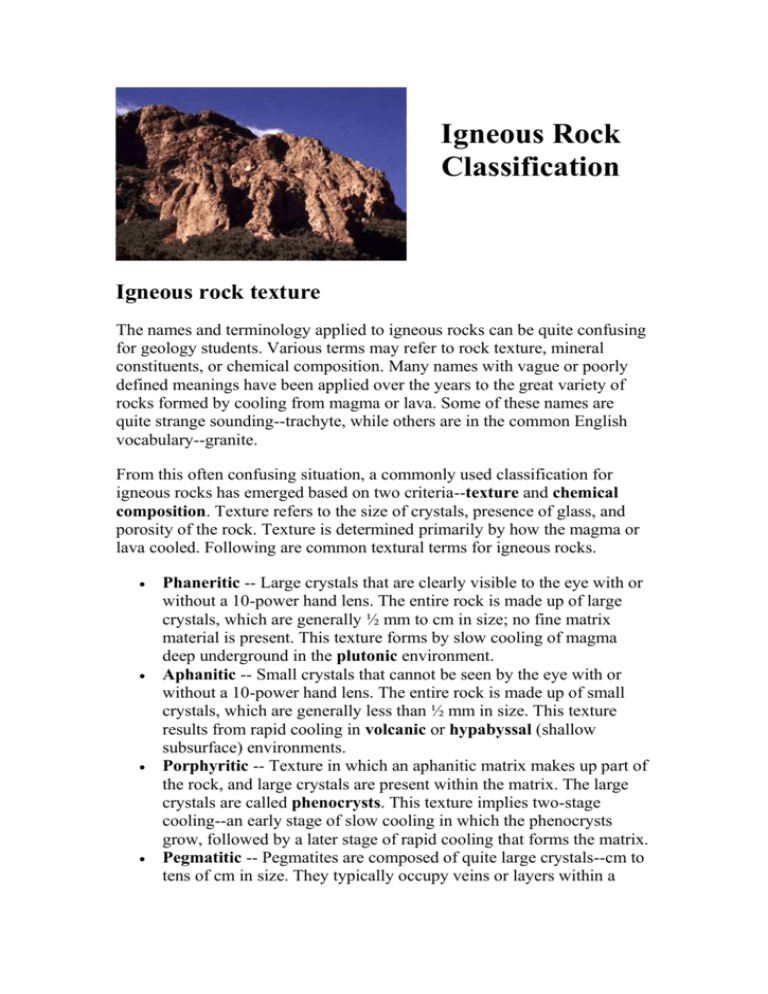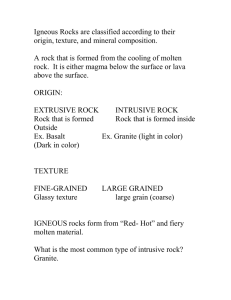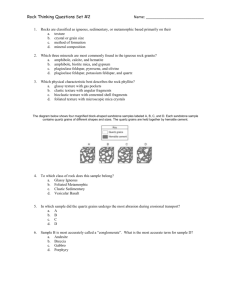Igneous Rock Classification
advertisement

Igneous Rock Classification Igneous rock texture The names and terminology applied to igneous rocks can be quite confusing for geology students. Various terms may refer to rock texture, mineral constituents, or chemical composition. Many names with vague or poorly defined meanings have been applied over the years to the great variety of rocks formed by cooling from magma or lava. Some of these names are quite strange sounding--trachyte, while others are in the common English vocabulary--granite. From this often confusing situation, a commonly used classification for igneous rocks has emerged based on two criteria--texture and chemical composition. Texture refers to the size of crystals, presence of glass, and porosity of the rock. Texture is determined primarily by how the magma or lava cooled. Following are common textural terms for igneous rocks. Phaneritic -- Large crystals that are clearly visible to the eye with or without a 10-power hand lens. The entire rock is made up of large crystals, which are generally ½ mm to cm in size; no fine matrix material is present. This texture forms by slow cooling of magma deep underground in the plutonic environment. Aphanitic -- Small crystals that cannot be seen by the eye with or without a 10-power hand lens. The entire rock is made up of small crystals, which are generally less than ½ mm in size. This texture results from rapid cooling in volcanic or hypabyssal (shallow subsurface) environments. Porphyritic -- Texture in which an aphanitic matrix makes up part of the rock, and large crystals are present within the matrix. The large crystals are called phenocrysts. This texture implies two-stage cooling--an early stage of slow cooling in which the phenocrysts grow, followed by a later stage of rapid cooling that forms the matrix. Pegmatitic -- Pegmatites are composed of quite large crystals--cm to tens of cm in size. They typically occupy veins or layers within a larger plutonic body. The large crystals form by slow cooling of magma. Glassy -- Non-crystalline (glassy) structure of the rock, in which no minerals are present. Glass results from cooling that is so fast that minerals do not have a chance to crystallize. This may happen when magma or lava comes into quick contact with much cooler materials near the Earth's surface. Pure volcanic glass is known as obsidian. Vesicular -- This term refers to vesicles (holes, pores, or cavities) within the igneous rock. Vesicles are the result of gas expansion (bubbles), which often occurs during volcanic eruptions. Pumice and scoria are common types of vesicular rocks. Breccia -- A rock composed of broken, angular fragments of mixed composition. Such texture forms in volcanoes, along fault zones, and in landslides. Igneous rock composition Classification based on chemistry takes into account the amount of silica (SiO2) and the composition of feldspar minerals (K, Na, Ca). Igneous rock chemistry is determined mainly by the source of the magma and any interactions between magma and the rocks through which it migrates. Chemical composition usually is indicated by the minerals or color of an igneous rock. Four main compositional categories result from this approach (based on Travis 1955). 1. Felsic -- Rich in feldspars and silica. Silica content ranges from about 55% to > 70%. Potassium feldspar makes up more than one-third of total feldspars; plagioclase (Na & Ca) feldspars are less than twothirds of total feldspars. Typical of continental crust. 2. Intermediate -- Between felsic and mafic. Silica content ranges from about 55% to 65%. Plagioclase feldspars make up more than twothirds of total feldspars. Na-rich plagioclase predominates over Carich plagioclase. Found in association with subduction zones. 3. Mafic -- Rich in magnesium and iron with less silica. Silica content is 45% to 50%. Ca-rich plagioclase is the dominant feldspar with little or no K- or Na-feldspars. Typical of oceanic crust. 4. Ultramafic -- Still more magnesium and iron and even less silica. Silica content is less than 45%, and little or no feldspar is present. Derived from the mantle. Igneous rock classification Texture combined with chemical composition is the basis for modern classification of igneous rocks. Although chemical composition cannot be "seen" in the field, it can be estimated based on the main minerals of a rock specimen. The classification below considers the amount of quartz and the types of feldspar (K, Na, Ca) varieties as primary indicators for chemical composition. Classification of common igneous rocks based on texture and composition. Adapted from Travis 1955. Composition Phaneritic (main minerals) Aphanitic Color Granite (>10% quartz, >2/3s K-feldspar) Syenite (<10% quartz, >2/3s K-feldspar) Monzonite (1/3 to 2/3s K-feldspar) Felsic Granodiorite (>10% quartz, >10% K-spar, >2/3s Na-spar) Intermediate Diorite (<10% quartz, <10% K-feldspar, >2/3s Na-feldspar) Mafic Gabbro (<10% quartz, >2/3s Ca-feldspar, olivine) Ultramafic Peridotite (pyroxene and olivine; no quartz or feldspar) Rhyolite Trachyte Latite 10 15 20 Dacite Andesite 20 25 Basalt Lamprophyre* 50 95 * Lamprophyre is a special igneous rock of mafic composition. It is porphyritic and occurs in shallow (hypabyssal) intrusions. The phenocrysts consist of mafic minerals (biotite, hornblende and pyroxene); the same mafic minerals are found in the fine groundmass along with feldspars. Some dikes of the Spanish Peaks region are lamprophyres. The color index (right column of table) indicates the percentage of darkcolored minerals in the rock. Dark-colored minerals include olivine, pyroxene, biotite, hornblende, and iron oxides, which are generally dark green to black. Quartz, feldspars, and muscovite are light-colored. This includes pink and red potassium feldspars as well as gray Ca-rich plagioclase. Color index is somewhat variable and works best with phaneritic rocks. The color index is more difficult to apply to aphanitic rocks, as their hue and brightness vary considerably. For example, rhyolite may be pale gray, green, or pink to dark red. Andesite is usually moderate gray or green, and basalt is dark gray to black. However, the colors for glassy rocks (obsidian, scoria, pumice) are meaningless as indicators for chemical composition. Reference Travis, R.B. 1955. Classification of rocks. Colorado School Mines, Quarterly 50/1, 98 p.







